TL;DR
How does Grass stand out among the DePIN projects?
The core factor is zero-cost with no threshold. Users are the cornerstone, and other factors are leverage.
Grass uses the dual engines of technology + model to break through the DePIN involution - ensuring data authenticity through zero-knowledge proof and Solana Layer 2 architecture to solve the dirty data pain point in the AI industry; at the same time, using the bandwidth mining → points incentive model to convert 2.5 million users into data nodes, forming a crushing advantage on the supply side.
The surge in demand for AI data, the popularity of Solana and DePIN, and reasonable operational methods have made DePIN a leader in AI data.
What factors should be paid attention to in Grasss subsequent participation?
In the short term, we will see whether the decentralized transition will be successful in 2025.
In the medium term, demand verification: the scale of AI enterprise procurement data;
Look at the compliance game in the long term: data privacy and ownership rules.
The biggest risk at present is that “token carnival masks demand vacuum” - if AI customer orders fail to increase in volume in the future, the perfect business flywheel may degenerate from a positive cycle of “data-capital” into a supply-side bubble.
The report is about 12,000 words and is expected to take 10 minutes to read (this report is produced by DePINone Labs, please contact us for reprinting)
1. Industry Background
When DePINs democratization of computing power meets AIs data dilemma, a data equality movement quietly breaks out.
DePIN integrates idle global resources (computing power, storage, bandwidth) through the token economy to build a distributed infrastructure network; at the same time, the AI industry faces a structural shortage of data, monopoly by giants, privacy disputes and island barriers, resulting in 80% of data value not being released.
The future AI competition is essentially a dual game between data acquisition efficiency and ethical compliance, and DePIN provides the optimal technical solution.
The disruptive nature of Grass lies in the fusion of these two.
1.1 DePIN: Reconstructing the global paradigm of infrastructure
Definition and core logic
In recent years, with the maturity of blockchain technology and the rise of Web3 concepts, all walks of life are exploring decentralized transformation paths. DePIN is the embodiment of this trend in the field of infrastructure. DePIN (full name Decentralized Physical Infrastructure Networks) is a new economic model that integrates global decentralized physical resources (such as computing power, storage, bandwidth, energy, etc.) through blockchain technology.
Its core logic is to drive the community to contribute idle resources through token incentives, build a decentralized infrastructure network, and replace the high-cost and low-efficiency model of traditional centralized service providers.
Industry drivers
Compared with the centralized model, the decentralized transformation of physical infrastructure has greater advantages in terms of cost structure, governance model, network resilience, and ecological scalability.
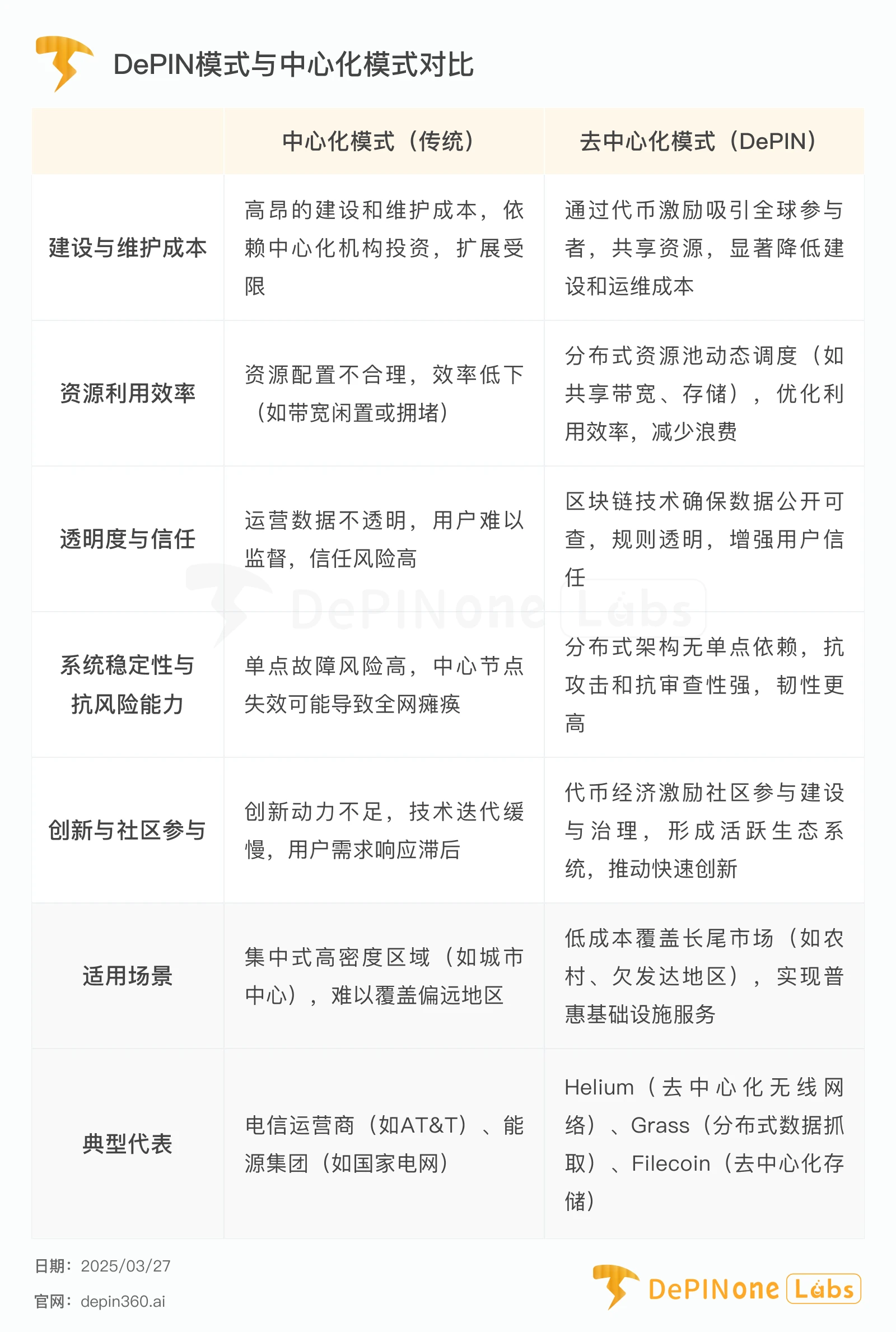
Segmentation and typical cases
According to Messaris definition, DePIN covers two major categories: physical infrastructure (such as wireless networks, energy networks) and digital resource networks (such as storage and computing), and realizes supply and demand matching and incentive mechanisms through blockchain technology.
Physical infrastructure: represented by Helium (decentralized wireless network), building a global communication network through community deployment of hotspot devices;
Digital resource network: including Filecoin (decentralized storage), Aethir (distributed computing), etc., forming a shared economic model by integrating idle resources.
Market Potential
According to Messari data, by 2024, the number of DePIN devices worldwide will exceed 13 million, with a market size of US$50 billion, but the penetration rate is less than 0.1%. It is expected to grow 100-1000 times in the next decade.
By 2024, the total market value of the DePIN track will reach US$50 billion, covering more than 350 projects, with an annual growth rate of more than 35%.
Its core driving force lies in the bilateral effects of improved resource efficiency (such as utilization of idle bandwidth) and explosive demand (such as AIs demand for computing power and data).
Of course, the scalability, data privacy, and security verification of decentralized networks remain key challenges for the development of DePIN.
1.2 AI Data Demand: Explosive Growth and Structural Contradictions
“Data is the new oil”
The acquisition and processing of AI data is a core driver of the development of artificial intelligence, especially when training large language models (such as GPT) and generative neural networks (such as MidJourney).
The performance and effectiveness of AI models largely depend on the quality and quantity of training data. High-quality, diverse, and geographically representative data is critical to the performance of AI models.
Data demand scale and characteristics
Massive increase: Taking GPT-4 as an example, training requires more than 45 TB of text data, and the iteration speed of generative AI requires real-time data update and diversification;
Cost share: The cost of data collection, cleaning and labeling in AI development accounts for more than 40% of the total budget, becoming the core bottleneck of commercialization;
Scenario differentiation: Autonomous driving requires high-precision sensor data, medical AI relies on a privacy-compliant case database, and social AI relies on user behavior data.
Pain points of traditional data supply
Data barriers: Core enterprises/entities and other giants control a wide range of data sources, and small and medium-sized developers face high barriers and unfair pricing;
Data silos: Data are often scattered among different institutions and enterprises. Data sharing and circulation face many obstacles, which leads to the inability to fully utilize data resources.
Data privacy: Data collection often involves privacy and copyright disputes, such as the Reddit API charging incident that triggered developer protests;
Inefficient circulation: Data silos and lack of standardization lead to duplicate collection, and global data utilization rate is less than 20%;
Disruption of the value chain: Individual contributors who create data cannot profit from the subsequent use of the data.
DePIN’s path to success
Distributed data collection: Capture public data (such as social media and public databases) through a node network to reduce the cost of data collection and improve the efficiency and scale of data collection;
Improve data quality and diversity: Through the DePIN incentive mechanism, more participants can be attracted to contribute data, thereby improving the quality and diversity of data and enhancing the generalization ability of AI models.
Decentralized cleaning and labeling: Community collaboration completes data preprocessing, combined with zero-knowledge proof (ZK) to ensure data authenticity;
Tokenized incentive closed loop: Data contributors are rewarded with tokens, and demanders use tokens to purchase structured data sets, forming a direct match between supply and demand
The Grass project is located at the intersection of DePIN and the AI data industry. It innovatively applies the DePIN concept to the field of AI data collection and builds a decentralized data capture network, aiming to provide a more economical, efficient and reliable data source for AI model training.
In the following chapters, we will deeply analyze the specific mechanism, technical characteristics, application scenarios and future development prospects of the Grass project.
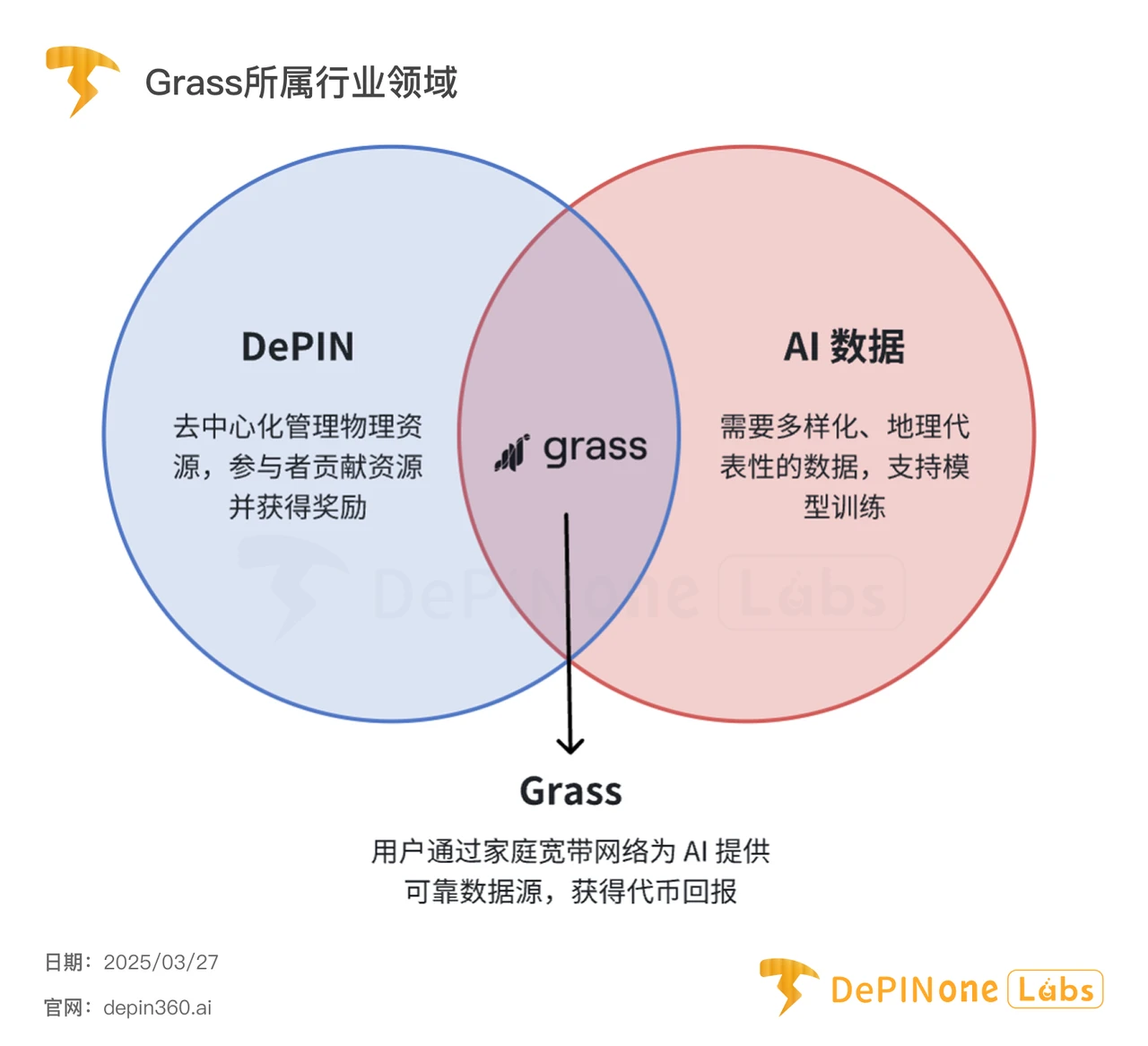
2. Basic information of the project
Grass rapid expansion is inseparable from its extremely low participation threshold. It allows every user to become a miner of AI data and exchange idle bandwidth for future dividends.
Grass builds a decentralized data capture network through the DePIN architecture, providing cost-effective and diverse data sources for AI training. Users only need to install the client to contribute bandwidth to obtain token rewards. It has attracted more than 2.5 million nodes in one year since its launch, and the token has increased more than 5 times in 10 days since its launch, verifying its business logic.
The project has received investments from top capitals such as Polychain and Hack VC, and relies on the Solana high-performance chain to achieve data ownership confirmation and circulation.
The anonymity of the current team is still controversial, and the progress of decentralized data processing needs to be followed up.
2.1 Business Scope
Grass is a DePIN project that collects and verifies Internet data through the unused bandwidth of user devices, specifically to support artificial intelligence (AI) development.
At its core, it allows companies to use users Internet connections to access and crawl Internet data in different geographic locations through a residential proxy network, which is very useful for AI model training that requires diverse and geographically representative data.
Problem solved: Traditional web crawling is usually done by centralized systems, which is inefficient and prone to errors or biases. Grass aims to provide reliable and verified Internet data in a decentralized manner, and the data provided by decentralized users is naturally diverse, multi-regional, and real-time.
Vision and Mission: Grasss vision is to create a decentralized Internet data layer where data is collected, verified, and structured in a trust-minimized manner. Its mission is to empower users to contribute to the data layer and incentivize participation through a reward mechanism.
How to participate: Users can get started in just three steps: visit the Grass official website, install the extension/client, connect and start earning Grass Points. This way of contributing bandwidth to earn rewards provides ordinary users with an opportunity to share the dividends of AI growth.
In summary, the key features and advantages of Grass are: decentralized networks have low data capture costs and richer data diversity; users earn rewards by contributing bandwidth and realize data value return; blockchain technology is used to verify data to ensure data transparency and reliability.
2.2 Development History
Concept Phase: In mid-2022, the project was conceptualized by Wynd Labs.
Development Phase: Product construction will begin in early 2023, marking the project’s entry into the actual development phase.
Seed round financing: In 2023, Grass completed a $3.5 million seed round led by Polychain Capital and Tribe Capital, for a total of $4.5 million (including a pre-seed round led by No Limit Holdings).
User testing: By the end of 2023, launch the Chrome browser extension and start user testing to attract early user participation.
Milestones: In April 2024, the project announced that it had more than 2 million connected node devices and is growing rapidly. According to DePIN Scan data, as of March 2025, it has more than 2.5 million active users.
First Airdrop: The first airdrop was announced on October 21, 2024, distributing 100 million GRASS tokens (10% of the total supply) to reward early users.
Exchange listing: It will be listed on OKX and other exchanges on October 28, 2024. The price will rise from $0.6 to $3.89 in 10 days, a steady increase of about 5 times.
Current status: The project continues to expand and is currently conducting the second phase of user idle incentives; plans to launch Android and iPhone mobile applications to increase network size and user engagement.
2.3 Team situation
According to Rootdata, Grass was developed by Wynd Labs and its founder is Andrej Radonjic, who is the CEO of Wynd Labs and holds a masters degree in mathematics and statistics from York University and a bachelors degree in engineering physics from McMaster University.
The team members are all from Wynd Labs, focusing on blockchain and AI technology development and have experience in related fields. However, the specific member information has not been widely disclosed, and only Radonjics identity has been disclosed.
According to Tracxn, Wynd Labs was founded in 2022 and its core product is Grass.
The team’s background shows expertise in blockchain and AI, but insufficient transparency could affect the trust of investors and users. Radonjic’s experience provides credibility for the project, but the anonymity of other members could raise concerns.
2.4 Financing and key partners
Investors and Support
Seed round: A $3.5 million seed round was completed in 2023, led by Polychain Capital and Tribe Capital. According to Rootdata, total financing after the seed round reached $4.5 million, including a pre-seed round led by No Limit Holdings.
Series A Financing: The Series A financing was completed in September 2024, led by HackVC, with participation from Polychain, Delphi, Lattice and Brevan Howard. The amount was not disclosed.
Investor support: HackVC, Polychain, Delphi, Lattice and Brevan Howard are all well-known investors in the industry. Their support also shows the recognition of the project in the industry.
Partners
Blockchain Platform: Built on the Solana network, the project leverages Solana’s high performance and scalability.
No specific collaborations with AI companies or other projects have been explicitly mentioned, but the Solana network’s ecosystem may provide opportunities for future collaborations.
3. Project technical analysis
Grass seeks to redistribute the value of data from big tech companies to ordinary users.
The node network, ZKP processing innovation, and data ledger in the Grass technical architecture form a closed-loop workflow, which is decentralized from collection, verification to delivery, and better supports its decentralized vision.
However, the current centralized operations need to be resolved, and whether the technology implementation can be smoothly implemented still needs to be tracked.
3.1 Core Technology Architecture: Sovereign Data Rollup
Grass is building the first sovereign data rollup. It simplifies data sourcing and transformation through a globally distributed network of Grass nodes, making structured web data universally accessible to AI. The infrastructure is powered by a dedicated data rollup on Solana and is designed to manage the full lifecycle of data — sourcing, processing, validation, and dataset construction. The architecture revolves around the following components:
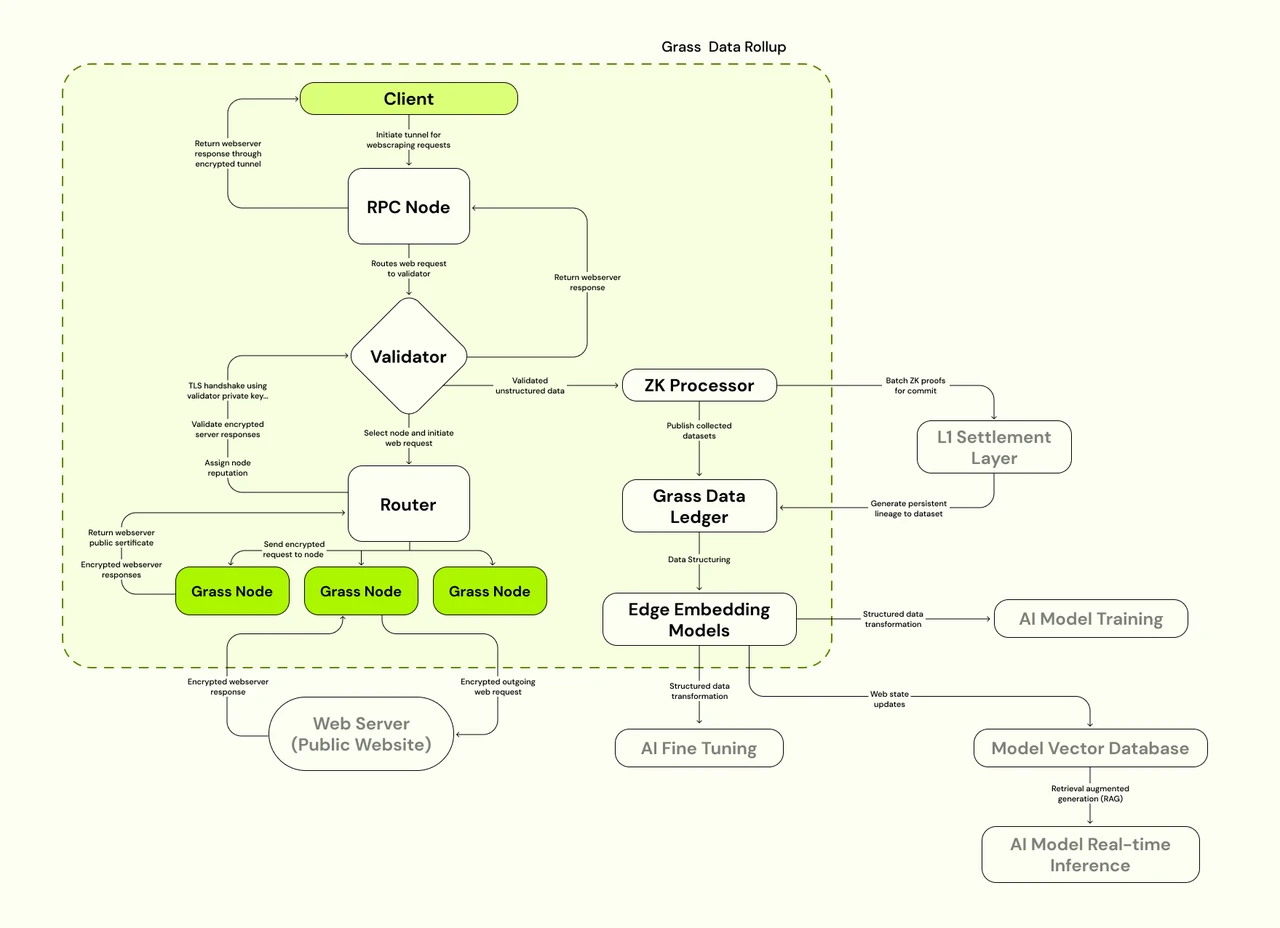
Disassembling the core components of Grasss technical architecture:
Node Network
It consists of three layers: validator, router, and Grass node.
Users share unused Internet bandwidth by installing browser extensions/desktop applications, forming Grass nodes and gathering them to form a global distributed network. Currently, Grass has more than 2.5 million nodes, covering more than 190 countries, and captures about 100 TB of data every day, providing a diverse and geographically representative data source for AI development.
GRASS routers connect GRASS nodes to validators. Routers are responsible for node networking and relaying bandwidth.
Validators receive, verify, and batch the transactions distributed by the routers. They then generate ZK proofs to check session data on-chain. At the current stage, data collection is handled by a centralized system, and in the future, it is planned to be decentralized through a Layer 2 network.
Zero-Knowledge Proof (ZK) Processor
Grass uses zero-knowledge proofs to verify the source of data and ensure data privacy and integrity. ZK processors generate on-chain proofs to verify the source of data and track its life cycle, enhancing data credibility. As Donovan Choy said, the application of ZKP solves the trust problem of traditional web crawling and provides transparency for the AI data market.
Data Ledger
Grass Data Ledger is the link between captured data and L1 settlement layer. Data is recorded on the blockchain through Grasss Layer 2 network (based on Solana) to form a Sovereign Data Rollup. This ensures the transparency and traceability of data, and supports AI developers to efficiently access structured data sets.
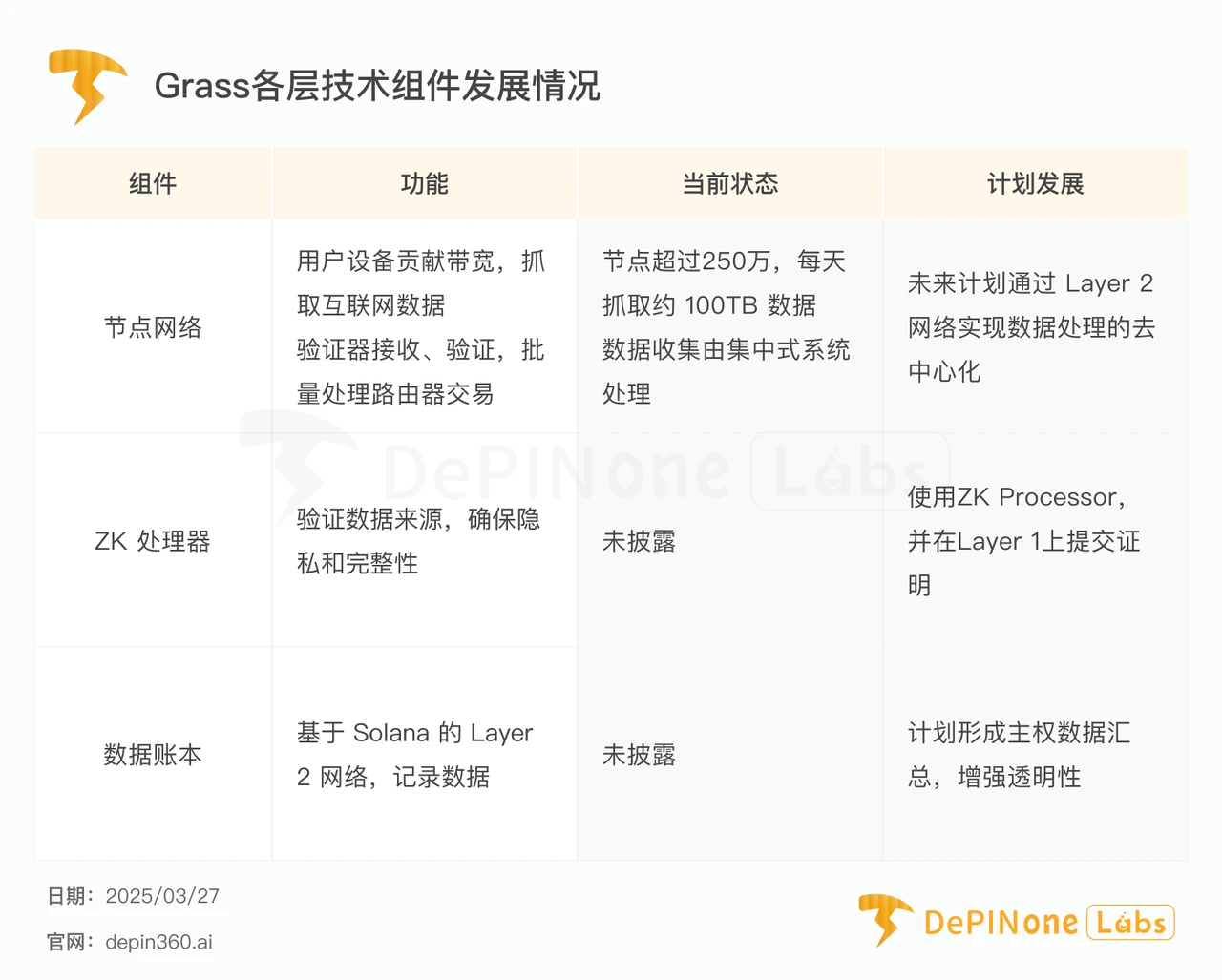
3.2 Technological breakthrough and rationality
In the architecture disclosed by Grass, each layer has technical highlights.
Applying the DePIN concept to web data crawling fills the gap in the decentralization of AI data collection. This is the first large-scale application of DePIN in the field of data infrastructure.
Using ZKP to verify data origin solves the privacy and trust issues of traditional centralized crawling, which is one of its technical highlights.
Build a Layer 2 network to handle high-throughput data transactions, taking advantage of Solana’s low cost and high efficiency.
In addition, Grass plans to launch Live Context Retrieval technology in the first quarter of 2025, which will further enhance its ability to provide real-time data for time-sensitive AI models.
Grass’ technical design is not just limited to a single-level highlight, but forms a complete solution that supports its technological vision.
Grasss vision is to create a decentralized Internet data layer that provides a reliable and trusted data source for AI development.
The scale of the node network can support the provision of diverse data sources, which is in line with the principles of decentralization and democratization.
ZKP’s privacy protection capabilities ensure user data security and enhance user trust.
The deployment plan of Layer 2 network will improve network efficiency and scalability and support large-scale data processing needs.
However, it is still in the testing phase, and data collection is handled by a centralized system, which may limit its full decentralization. We need to pay attention to the deployment progress of the future Layer 2 network to ensure the realization of the vision.
4. Business Model Flywheel
Grass presents a nearly perfect business flywheel, which can generate supply but not demand.
Supply side: 2.5 million nodes capture 100 TB of raw data per day, which is verified by ZK to form a compliant data set;
Demand side: AI companies purchase on demand, and the benefits are fed back to the ecosystem through tokens, completing the alchemy of bandwidth → data → cash flow. (The demand side has not yet been verified - whether AI companies will pay for decentralized data still needs to be proven by large-scale orders.)
4.1 Closed loop business model: making full use of token incentives
Grass’ business model can be summarized as follows: users contribute bandwidth to obtain Grass Points rewards → scrape public data resources on the web → AI companies purchase data → profits form a closed loop through token distribution.
User contributed bandwidth
Users share bandwidth by installing extensions/desktop applications, and recommending friends provides 20% direct rewards and second-level and third-level rewards of 10% and 5%.
Grass Points are calculated based on factors such as bandwidth usage and geographic location, and there are plans to add rewards based on milestones and online time in the future.
Scrape web public data resources
Grass nodes utilize users unused bandwidth and relay traffic so that the network can crawl public web data.
Grass’s residential proxy network provides AI developers with a diverse and geographically representative data source.
AI Enterprise Purchase Data:
AI companies purchase structured data sets through the Grass network for model training.
Revenue closed loop:
The network revenue is distributed to users through GRASS tokens, forming a sustainable incentive mechanism. Grass Points can be converted into GRASS tokens, with a total supply of 1 billion. The community allocates 300 million tokens for future incentives and router rewards to ensure long-term development.
Tokens can be used to stake routers to support network traffic and earn rewards through network activity.
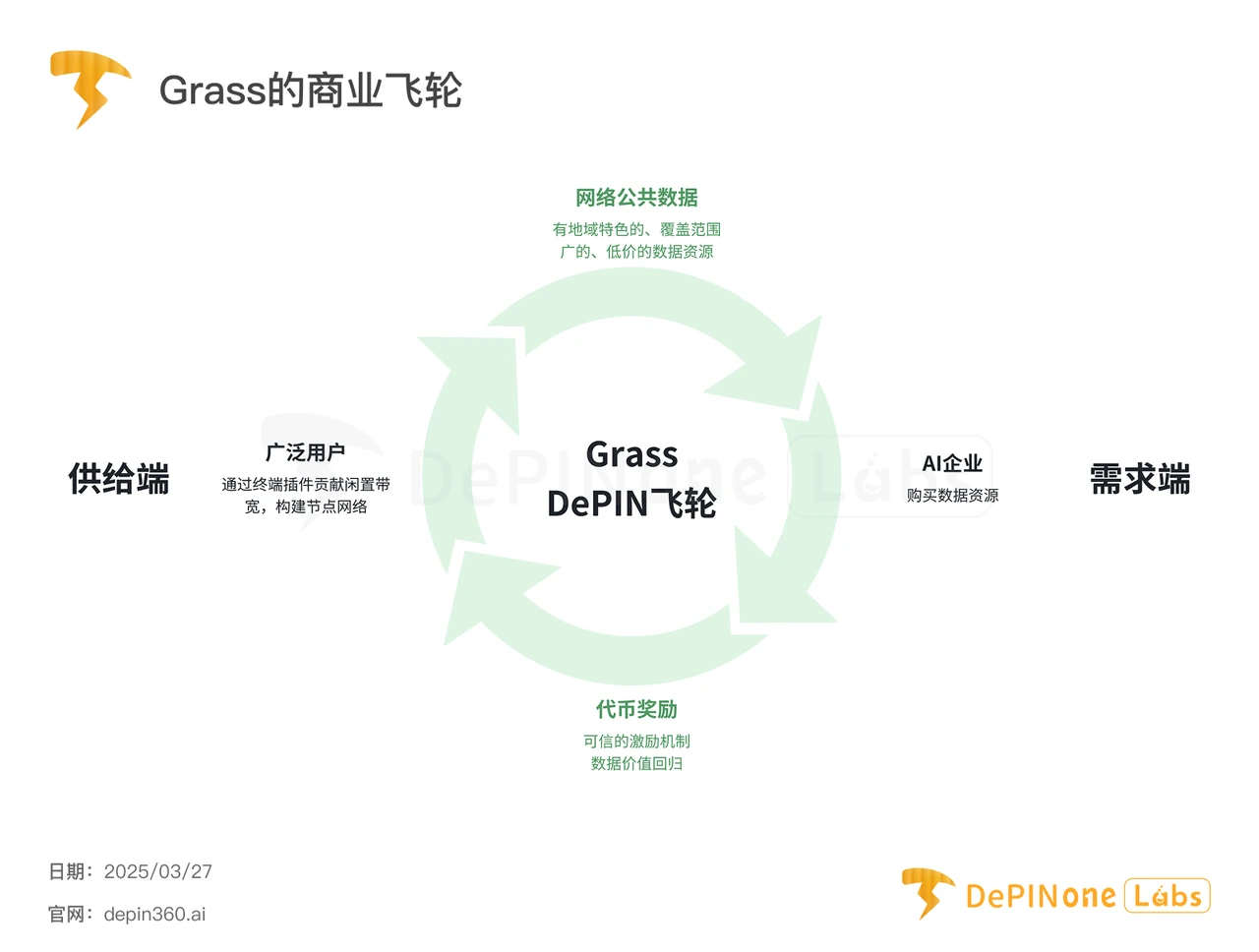
4.2 Model Innovation and Success
The biggest innovation in Grass’s business model is the formation of a positive feedback loop through the referral system and token rewards. Of course, this is also the commonality of most DePIN projects.
Grass attempts to redistribute data value from big tech companies to ordinary users. Applying the DePIN model to the AI data market creates passive income opportunities for users and subverts the profit model of traditional centralized agency networks (such as Luminati and Honeygain).
The success of its business model is closely related to any of the following factors:
High user engagement: Over 2.5 million users as of March 2025, demonstrating ease of use and community appeal.
Market fit: The demand for AI data is growing rapidly, and Grass fills the gap in the decentralized data layer, which is in line with industry trends.
Economic incentives: Through token rewards and referral systems, a positive feedback loop is formed to attract more users to participate.
4.3 Flywheel Risk
Consistent with the vast majority of DePIN projects, the weak spot in the supply-demand business flywheel lies on the demand side.
The token incentive model allows the project to more easily achieve supply-side aggregation, but we have not yet seen the official results on whether the massive amount of data can be cleaned and processed properly to make it a standard product that the B-side is willing to pay for.
In the design of the Grass project, they will be involved in both the provision of AI datasets and the preparation of analysis, so that AI companies that need extensive user text data (or businesses that find it useful to track media sentiment) can purchase it from users through Grass as an intermediary, rather than buying it from large technology companies.
We look forward to seeing further implementation of demand-side delivery in the future.
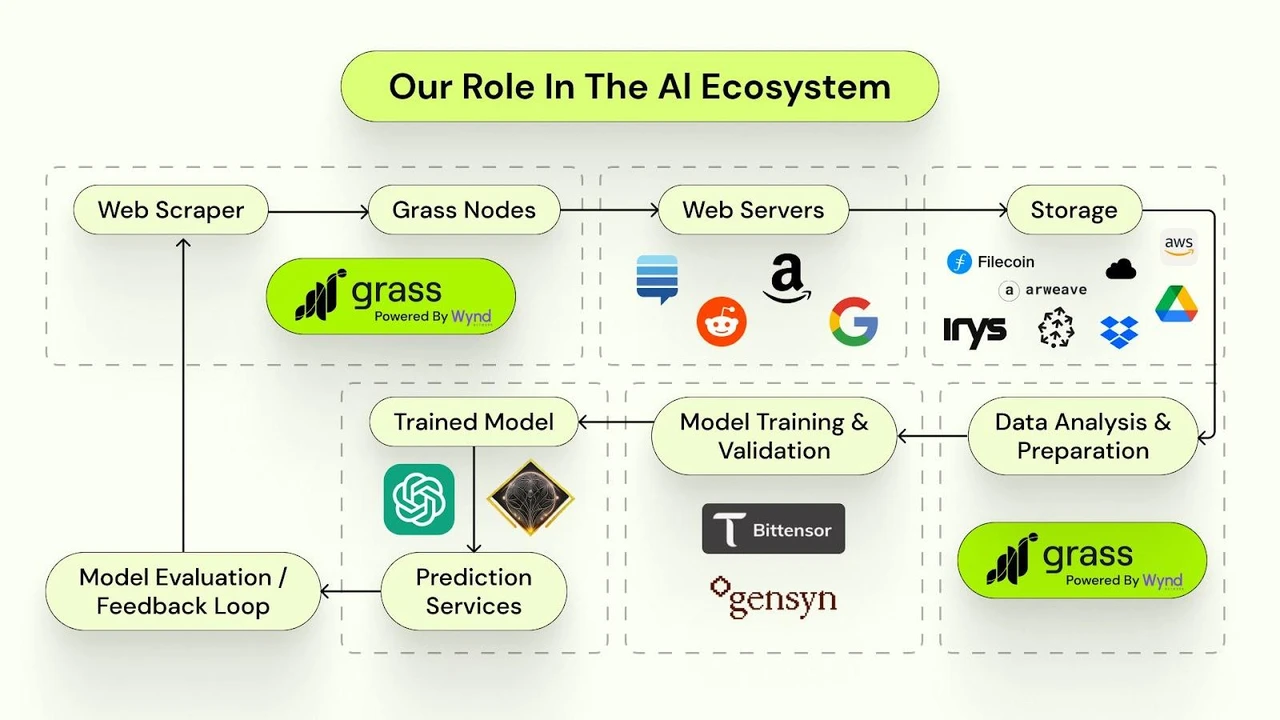
Another risk that needs to be noted is that Grasss model provides users with the opportunity to share in the growth dividends of AI, but attention should be paid to data privacy risks and the execution of decentralized transition.
5. Economic Model
When the capital feast ebbs, is the DePIN token the hard currency of AI data, or a chip in the game of passing the parcel?
The surge in Grass prices is mainly due to its large user base, exchange listing and the hot sentiment in the DePIN market, coupled with operational user incentives and community participation to rapidly expand the user base.
However, attention should be paid to the impact of early investor unlocking and airdrop disputes, as well as whether demand-side verification can support long-term development.
5.1 Token Model
Grasss token economic model is based on its native token $GRASS, with a fixed total supply of 1 billion.
According to its GitBook documentation, the token distribution is as follows:
Community: 30% (300 million), including:
Future Incentives: 170 million for retroactive program rewards to early contributors and developers who create valuable content or tools for the network.
Router rewards: 30 million, used to incentivize routers to support network traffic and reduce latency.
First airdrop: 100 million (10% of total supply), distributed on October 28, 2024, rewarding more than 2.5 million users.
Foundation and Ecosystem Growth: 22.8% (228 million), held by the Foundation to support network operations, upgrades, partnerships, and RD.
Early investors: 25.2% (252 million tokens), with a 1-year lock-up period and a 1-year vesting period to ensure long-term commitment.
Team: 22% (220 million tokens), with a 1-year lock-up period and a 3-year vesting period to encourage long-term development of the team.
Token uses include:
Rewards: Incentivize users to contribute bandwidth and refer others.
Staking: Users can stake GRASS tokens to routers to support network traffic and earn rewards. There is no minimum term and a 7-day lock-up period is required to unstake.
Governance: Token holders can participate in network decision-making, including voting on proposals and partner selection.
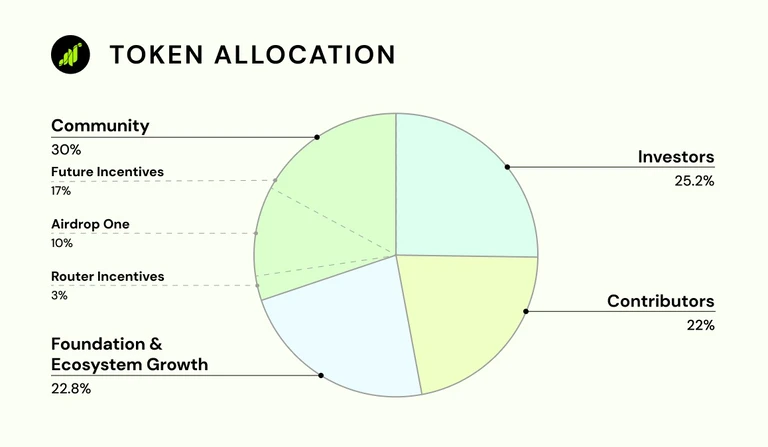
5.2 Token Market Analysis
The Grass projects token $GRASS was issued through the first airdrop on October 28, 2024, with an initial price of approximately US$0.64.
Subsequently, the price of the coin reached an all-time high of $3.90 on November 7, 2024, an increase of more than 500%, mainly due to the airdrop to attract a large number of users and listing on major exchanges such as Bybit, Gate.io, and Bitget. During the next two months, the price of the coin continued to fluctuate between $2 and $4, and the price of the coin was relatively stable.
Prices fell back in early 2025, but rebounded again in early March.
As of March 28, 2025, the GRASS token price is around $1.6, with a market cap of around $450 million and a 24-hour trading volume of $51.63 million (CoinMarketCap). The circulating supply is 243.905 million, indicating that some tokens have not yet been unlocked.

Compared with other projects listed at the same time, Grass’s coin price is undoubtedly the most eye-catching one: it increased fivefold in 10 days after its launch, and maintained a relatively stable high price for half a year.
Reasons for the surge in listing prices
GRASS tokens have experienced significant early surges since their launch, particularly in October and November 2024, reaching a peak of $3.90 (CoinMarketCap), driven by:
Large user base: The first airdrop on October 28, 2024 will distribute 100 million tokens, covering more than 2.5 million users and greatly increasing market liquidity.
The first network DePIN project token: Compared with the high threshold for participation in traditional DePIN projects, network idle projects led by Grass have greatly lowered the threshold for user participation. Among these projects, Grass is the first to conduct TGE, and it also broke the deadlock of no DePIN project ICO for a long time.
Exchange Listings: Tokens have been listed on major exchanges such as Bybit, Gate.io, and Bitget, increasing trading volume and investor interest.
Industry Market Sentiment: The boom in DePIN and AI-related projects boosted investor confidence, especially in the fourth quarter of 2024. CryptoRank.io noted that the activity in the Solana ecosystem also contributed to the price increase.
Staking mechanism: Grasss staking mechanism provides users with lucrative returns. By the end of 2024, the total amount of GRASS staked by users reached 27 million, accounting for 35% of the total supply. Compared with the industry average APR, Grasss 43.69% annualized rate of return has undoubtedly attracted the attention of many investors. As the demand for staking increases, the markets optimistic expectations for Grasss future growth have become more and more obvious.
Operational Enablers
Grasss operational strategy also plays a key role in price maintenance. Specific merits include:
User Incentive Mechanism: Rapidly expand the user base through the referral system (20% direct reward, 10% and 5% for the second and third levels), exceeding 2.5 million users by March 2025.
Community Engagement: Active community activity and transparent progress updates enhance market confidence, such as consistently sharing milestones via X posts.
Technological progress and market expectations: There are plans to launch Android and iPhone mobile applications, as well as the deployment of Layer 2 networks, to attract more investors. Bitget News mentioned that the announcement of the 2025 roadmap further boosted prices.
Development Risks
The current price of the currency is driven by the supply-side frenzy (low circulation + exchange listing effect), rather than the real demand for AI data procurement;
The false prosperity of staking APY up to 68% is actually the hidden cost of token inflation;
47.2% of the tokens are held by the team and early investors (220 million + 252 million), which will be gradually unlocked from 2025. If the demand side does not explode simultaneously, it may trigger selling pressure.
6. Project Ecosystem Analysis
Grass is in a leading position in AI data and idle network-based DePIN projects, with obvious competitive advantages.
The DePIN and AI data fields have great potential and broad room for industry growth; the Solana ecosystem supports its expansion.
6.1 Horizontal Comparison (Competition Analysis)
According to incomplete statistics, there are more than 600 projects in the DePIN industry with a total market value of more than 16 billion US dollars. In the last three months of 2024, Grass has topped the DePIN project popularity list of Rootdata.
There are too many projects for us to list one by one, so we select 3 representative projects for comparison: Filecoin, the market leader in the computing field, Helium, the market leader in the wireless transmission field, and Nodepay, the project that is closest to the Grass field and has also completed TGE.
Filecoin
Filecoin provides decentralized storage, where users can rent out unused storage space, based on the Filecoin blockchain, using FIL tokens. As of March 5, 2025, there are approximately 1,500 active miners with a market capitalization of approximately $2.5 billion.
Helium
Helium is a decentralized wireless network that primarily serves IoT devices. Users provide coverage by setting up hotspots and using HNT tokens. As of March 5, 2025, it has over 200,000 active hotspots and a market capitalization of approximately $200 million.
Nodepay
Nodepay is a network bot platform where users can contribute bandwidth to support AI training and provide user feedback to earn NC tokens. Market capitalization is approximately $10 million.
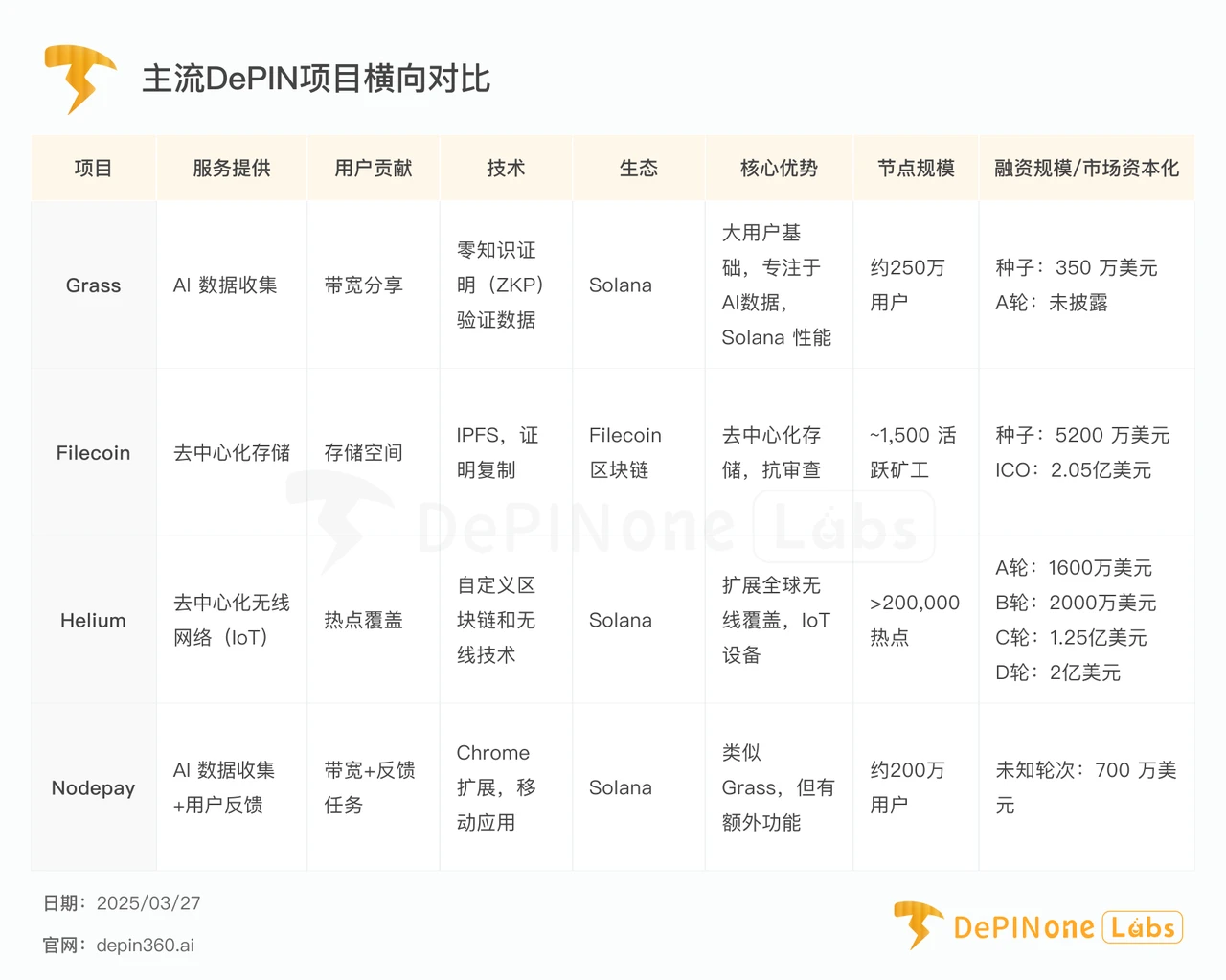
Service provision: Grass and Nodepay both focus on AI data collection, but Grass focuses more on bandwidth contribution, and Nodepay adds user feedback function; Filecoin provides storage services, and Helium provides wireless network coverage, with obvious differences in service areas.
User contribution: Grass and Nodepay rely on bandwidth, Filecoin relies on storage space, and Helium relies on hotspot settings. User participation varies.
Technology: Grass uses ZKP and Solana Layer 2, which are advanced technologies; Filecoin uses IPFS and proof-of-replication, Helium uses a custom blockchain, and Nodepay technology is less disclosed.
Blockchain: Grass and Nodepay are based on Solana and have strong scalability; Filecoin and Helium are independent blockchains.
Core advantages: Grass leads with its large user base and AI focus, Filecoin is censorship-resistant, Helium is suitable for IoT, and Nodepay has diverse functions but low technical credibility.
6.2 Vertical Potential (Industry Space)
Growth potential of DePIN and AI industries
The DePIN industry is growing rapidly, using blockchain to manage physical infrastructure networks. According to HTX Research, there are 650 projects in 2023 with a total market value of $35 billion, covering sub-fields such as storage, computing, and AI data collection.
Grass belongs to the subfield of AI, and according to DePIN Scan, there are 83 AI-related projects.
The AI data industry has huge demand. Model training requires high-quality and diverse data, and traditional methods face privacy and bias issues. Decentralized data collection provides a more secure and privacy-protected data source to meet the needs of AI development. Research shows that the AI market is expected to reach trillions of dollars in the next few years, and data demand continues to grow.
The combination of DePIN+AI creates a decentralized and secure way to collect data. Grass fills the gap in AI data infrastructure and captures about 90 TB of data every day, which is in line with industry trends.
Scalability supported by the Solana ecosystem
Grass is based on the Solana network, which is known for its high performance and scalability, making it a great fit for DePIN applications. Solanas fast transaction speed (thousands of transactions per second) and low fees support Grass to handle high-volume transactions, which can enhance its expansion potential.
There is also an active community and tooling in the Solana ecosystem to support Grass development and integration, and Layer 2 network plans to further improve efficiency.
Currently, Solana is the main platform for DePIN activities. According to public data, there are about 78 DePIN projects on Solana (data refer to statistics from platforms such as Messari and DePIN Scan as of 2024), covering wireless communications (such as Helium), computing resources (such as Render Network), geolocation (such as Hivemapper), cloud storage (such as GenesysGo SHDWDrive), etc. Grass leads the way in this ecosystem, contributing 2.5 million devices.
At this stage, Grass has already obtained the ticket to the AI data revolution and is a preemptive ecosystem builder. However, the Matthew effect of the DePIN track has begun to emerge, and giants have gradually entered the market with capital to copy its model. Grass needs to accelerate the establishment of data procurement agreement barriers.
7. Future Outlook
Grass is at the peak of the intersection of DePIN and AI, but the wave under its feet may be more turbulent than expected.
The weak demand side problem that DePIN projects generally face also happens to Grass. The key issue is whether the attractive business canvas can be implemented.
7.1 Project Development Route
At the first Founders Symposium of 2025, Grass outlined several key initiatives for the year ahead.
Key highlights of the Grass 2025 roadmap include multimodal search. Specifically, the platform plans to semantically enable AI models to search for insights from video, audio, and text data in real time. Grass also plans to adopt new distribution methods to expand its reach through mobile and other platforms, thereby simplifying user access and engagement.
In addition to this, the platform will deprecate the Chrome extension and introduce a more powerful and efficient desktop node. In addition, it will introduce Horizontal Scaling, a new product that will further expand its capabilities and ensure continued growth and innovation.
Another key highlight was the Sion Phase 1 results. The Grass platform is designed to improve network efficiency, enabling 60 times faster data retrieval.
“In case you’re wondering — in the days following Sion Phase 1, network activity was reduced to near zero to give our storage partners time to catch up. No one anticipated this level of capacity so early. Exciting times are ahead,” Andrej Radonjic, Grass contributor and co-founder of Wynd Network, said recently.
Based on Grasss current technological foundation, ecological layout, market performance, and the specific action plan that the official has disclosed, we can summarize Grasss future development path into three parts: technology iteration, ecological expansion, and governance upgrade.
Technology iteration
Lightweight node network and mobile deployment: It is planned to launch Android and iPhone mobile applications, allowing users to contribute idle bandwidth through their mobile phones to expand the user base and participation. According to Bitget News, the mobile application is expected to complete testing and be released in the second half of 2025.
Data Quality: The GRASS 2025 roadmap includes the deployment of Sovereign Data Rollup, which is expected to be completed in the fourth quarter.
Decentralized transition: Grass plans to complete the transition to full decentralization by the end of 2025, deploying a Layer 2 network based on Solana, using zero-knowledge proofs (ZKP) to verify data and ensure privacy and security. This will make data collection and verification more decentralized and enhance the trust and reliability of the network.
Ecosystem Expansion
Dataset collaboration: Grass has collaborated with Ontocord and LAION to create the VALID dataset, which will be further developed. This multimodal collection of 30 million audio clips, images, and text is the basis for AI model training and an important resource for developers.
Partnerships: GRASS plans to form partnerships with AI companies and other stakeholders to expand the utility and adoption of the network and attract more data buyers.
Governance upgrade
User incentive optimization: Grass will optimize its user incentive system, including adjusting the calculation method of Grass Points and the referral mechanism (20% direct reward, 10% and 5% for secondary and tertiary levels) to enhance user engagement and retention.
Community participation: The project will solve past problems such as the first airdrop distribution through transparent communication and community activities, rebuild community trust, and maintain long-term development. (The first airdrop caused dissatisfaction due to Phantom wallet issues, which need to be fixed through subsequent updates)
In general, Grass has a clear future development path, focusing on decentralization, user expansion, and technology upgrades, which is in line with the growth trend of the DePIN and AI industries.
However, attention should be paid to the technical complexity of the decentralized transition and the challenge of rebuilding community trust. If the above plan can be successfully implemented, Grass will be expected to maintain its position as a leader in AI data infrastructure.
7.2 Risks and Challenges
Model Risk
Grasss business model collects data through users contribution of bandwidth, sells it to AI companies, and uses the proceeds to reward users, forming a closed loop.
If the demand side (AI companies purchasing data) fails to materialize, Grass will not be able to generate enough revenue to reward users, users may lose motivation to participate, the network size will shrink, and data collection capabilities will be affected, forming a vicious cycle and ultimately the model will be unsustainable.
It is not yet clear how Grass will set its pricing data. If the price is too high, it may lose competitiveness; if the price is too low, it may not be able to cover operating costs.
Grass could lose market share if new data collection techniques, such as synthetic data, replace residential proxies. According to EnterpriseAI.news, synthetic data is on the rise and could reduce the need for real data.
Technical risks
The complexity of the transition to decentralization
The transition from centralized to decentralized involves technical complexity and may face scalability, security, and performance issues. The deployment of Layer 2 networks needs to ensure high throughput and low latency, and any technical failure may cause network disruption.
Research shows that the decentralized transition of similar projects has led to a decline in user experience due to scalability issues, and Grass needs to be managed carefully.
Data Quality and Integrity
In a decentralized network, data is collected by user devices and its quality and integrity must be ensured. Any data bias or malicious activity may affect the trust of AI developers. Data quality is the core challenge of all DePIN projects.
The implementation of ZKP needs to ensure that the source of data can be traced, but it may face efficiency issues and affect processing speed.
ZKP Efficiency and Cost
The efficiency of zero-knowledge proof directly affects network performance. Studies have shown that ZKP may increase computing costs in high-data-volume scenarios. Grass needs to optimize ZKP to balance privacy and performance.
Market Risk
Competitive pressure
Grass faces competition from centralized data providers like Luminati and decentralized competitors like Nodepay. Alternative projects may offer lower costs or richer features that will appeal to AI developers.
Continuous innovation is needed to maintain market leadership.
Regulatory compliance challenges
Data privacy regulations, such as GDPR, may place greater demands on decentralized data collection, and regulatory changes may increase operating costs or restrict certain activities.
Research shows that the DePIN project needs to adapt to the regulatory environment in different jurisdictions, and Grass may face compliance pressure.
Rebuilding community trust
The first airdrop distribution caused community dissatisfaction due to Phantom wallet issues, and trust needed to be rebuilt to maintain user engagement.
Any further community management mistakes could lead to user loss and affect long-term development.
Token Economic Management
The current coin price is driven by supply-side frenzy (low circulation + exchange listing effect) rather than real AI data procurement demand.
The total supply of GRASS tokens is 1 billion, and the distribution needs to be managed to avoid market volatility. Unlocking by early investors and teams may lead to price pressure, and it is necessary to balance user incentives and market stability.
7.3 Summary
Grass has shown significant potential in the field of DePIN and AI data. With its technological innovation, market positioning and large user base, it has taken the lead and is suitable for investors who pay attention to DePIN and AI trends. At this stage, it is still a good choice to continue to participate in Grass in a low-threshold form.
However, its technology implementation and market competition risks need to be closely monitored. Focus on the realization of the decentralized vision in technology, the verification of actual transactions on the demand side, and the continued growth of users after the launch of mobile applications. These are important milestones in the future development process. If the above issues can be achieved one by one, the long-term value of Grass is still worth looking forward to.
Special statement: All articles of DePINone Labs are for information and knowledge purposes only and do not constitute any investment advice.
Some reference content
Gitbook of Grass https://grass-foundation.gitbook.io/grass-docs/introduction
DePINs Imperfect Present Promising Future: A Deep Dive https://www.compound.vc/writing/depin (will be reproduced and interpreted later)
Reshaping the data layer of AI with Grass https://blockworks.co/news/depin-grass-reshaping-ai-data-layer
Grass DePIN Protocol Review: Data for AI and Monetization of Internet Connectivity https://medium.com/@alexanderallenme/grass-depin-protocol-review-data-for-ai-and-monetization-of-internet-connectivity-6b616f799134
Grass Unveils 2025 Roadmap: What You Need To Know https://www.bitget.com/news/detail/12560604497754
For AI that serves people, data curation DePINs hold the key | Opinion https://crypto.news/ai-that-serves-people-data-curation-depins-hold-key/
Special statement: All articles of DePINone Labs are for information and knowledge purposes only and do not constitute any investment advice.
This report is produced by DePINone Labs. Please contact us for reprinting.










